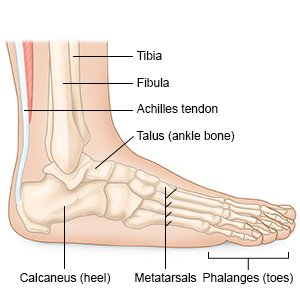ORIF of an Ankle Fracture
Medically reviewed by Drugs.com. Last updated on Apr 6, 2025.
Open reduction and internal fixation (ORIF) of an ankle fracture is surgery to fix a broken ankle. You may need surgery to repair a talar fracture. The talus is a square, flat bone on top of the heel bone. It connects your heel bone with the tibia and fibula (lower leg bones) to form the ankle. Open reduction means the bones will be put back into the correct position. Internal fixation means hardware (such as wires, screws, pins, or plates) is used to hold the bones in place while they heal.
 |
DISCHARGE INSTRUCTIONS:
Call your local emergency number (911 in the US) if:
- You suddenly feel lightheaded and short of breath.
- You have chest pain when you take a deep breath or cough. You cough up blood.
Seek care immediately if:
- Your arm or leg feels warm, tender, and painful. It may look swollen and red.
- Blood soaks through your bandage.
- Your toes look pale or blue, feel numb, or tingle.
Call your doctor or surgeon if:
- You have a fever.
- Your cast or splint breaks or gets damaged or wet.
- Your cast or splint begins to smell.
- You have more pain or swelling than you did before the cast or splint was put on.
- You have questions or concerns about your condition or care.
Medicines:
You may need any of the following:
- Prescription pain medicine may be given. Ask your healthcare provider how to take this medicine safely. Some prescription pain medicines contain acetaminophen. Do not take other medicines that contain acetaminophen without talking to your healthcare provider. Too much acetaminophen may cause liver damage. Prescription pain medicine may cause constipation. Ask your healthcare provider how to prevent or treat constipation.
- Antibiotics help prevent or fight an infection caused by bacteria.
- Take your medicine as directed. Contact your healthcare provider if you think your medicine is not helping or if you have side effects. Tell your provider if you are allergic to any medicine. Keep a list of the medicines, vitamins, and herbs you take. Include the amounts, and when and why you take them. Bring the list or the pill bottles to follow-up visits. Carry your medicine list with you in case of an emergency.
Self-care:
- Use crutches as directed. Crutches will decrease the stress on your ankle when you walk. It is important to use crutches correctly. Ask your healthcare provider for more information about how to use crutches.
- Ask when you can bathe. When you are allowed to bathe, cover your cast with 2 plastic bags. Tape the bags to your skin to keep the water out. Keep the cast out of the water so it does not get wet. If you do not have a cast, carefully wash the wound with soap and water. Dry the area and put on new, clean bandages as directed. Change your bandages when they get wet or dirty.
Cast or splint care:
- Check the skin around the cast or splint every day. Apply lotion on any red or sore areas.
- Do not push down or lean on any part of the cast or splint.
- Do not scratch the skin under the cast with any sharp or pointed object inside the cast.
- If your splint is too tight, gently loosen it so that your toes are comfortable.
Go to physical therapy, if directed:
A physical therapist teaches you exercises to help improve movement and strength, and to decrease pain.
Follow up with your doctor or surgeon as directed:
You will need to return to have your wound checked and stitches removed. Write down your questions so you remember to ask them during your visits.
© Copyright Merative 2025 Information is for End User's use only and may not be sold, redistributed or otherwise used for commercial purposes.
The above information is an educational aid only. It is not intended as medical advice for individual conditions or treatments. Talk to your doctor, nurse or pharmacist before following any medical regimen to see if it is safe and effective for you.
Further information
Always consult your healthcare provider to ensure the information displayed on this page applies to your personal circumstances.
